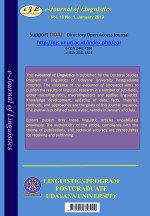Improving Dayaknese-Speaking Learners’ English Pronunciation
Abstract
The L1 influence causes difficulties for Dayaknese-speaking leaners (hereinafter referred to as learners) of English in producing English sounds. In English, pronunciation plays important role to understand the communication. The purposes of learning English pronunciation for learners are (1) able to communicate in English clearly and intelligibly, (2) able to get the meaning of information conveyed in real life situations, (3) able to improve self-confidence while communicating oral English, and (4) able to monitor the use of English (able to listen, understand, and produce). The teaching of English subject in Indonesian schools includes four skills, namely listening, speaking, reading, and writing. While linguistic elements, such as vocabulary, grammar, pronunciation, and cultural patterns of discourse are the supporters of these four skills.
This current research aimed to describe the implementation of behaviorism learning method and communicative approach as an attempt to improve English pronunciation for learners. This current research was conducted by means of Research and Development (R & D) design, employing the stages as follows: analysis, design, development, implementation, and evaluation. Testing was done with experiment, which compares the effectiveness between the old (conventional) learning method and the new method (behaviorism learning method with a communicative approach). The indicators of the effectiveness of new method were the speed of the learners’ understanding, the learners’ creativity, and the learners’ learning outcomes. Experiment was carried out by comparing with previous condition and after using a new learning method (before-after) or also called one group pretest-posttest. Based on statistical count, t count = -34.37 and t table = 1.67, the value of t count falls on Ha acceptance area (new learning method was more effective than conventional learning method) or Ha was accepted and Ho was rejected.
Downloads
References
Brown, H. Douglas. (2007). Prinsip Pembelajaran dan Pengajaran Bahasa. (Cholis, Noor dan Pareanom, Yusi Avianto, Penerjemah). USA: Pearson Education, Inc.
Branch, Robert Maribe and Dousay. 2015. Survey of Instructional Design Models. USA:
AECT.
Carson, Karyn Louse. (2012). Efficient and Effective Classroom Phonological Awareness Practices to Improve Reading Achievement. (Thesis). New Zeland: College of Education University of Canterbury.
Celce-Murcia, Marianne et al. (2008). Teaching Pronunciation: A Reference for Teachers of English to Speakers of other Languages. Cambridge: Cambridge University Press.
Creswell, John W. 2009. Designing and Conducting Mixed Methods Research (2nd Edition). New York: SAGE Publications, Inc.
Davenport, Mike and Hannahs. (2005). Articulatory Phonetics. London: Hodder Arnold.
Dӧrnyei, Zoltán. (2007). Research Methods in Applied Linguistics. Oxford: Oxford University Press.
Elmaksoud, Mukhtar Abd Elfattah.2013. The Effective of Using Communicative Approach on Developing Pronunciation Sub-Skill. Egypt: Beni-Suef University. International Research Journal (ISSN: 2141-5161)vol. 4 (3) pp.294-308. Diunduh dari http://www: interesjournals.org/ER
Els, Theo Van et al. 1991. Applied Linguistics and the Learning and Teaching of Foreign Languages. Edward Arnold Publisher Ltd.Hadley, Gregory. 2008. Action Research in Action.Singapore: SEAMEO Regional Language Centre.
Fernandez, Eva M and Cairns. (2011). Fundamentals Psycholinguistics. UK: Wiley Blackwell Ltd.
Fraser, Helen. (2001). Teaching Pronunciation: A Handbook for Teachers and Learners. New South Wales: DETYA (Department of Education Training and Youth Affairs).
Kayi, Hayriye. (2006). Teaching Speaking: Activities to Promote Speaking in Second Language. The Internet Journal, Vol. XII, No. 11, November 2006. Retrieved 13rd April, 2014 from http://iteslj.org/.
Kelly, Gerald. (2006). How to Teach Pronunciation. England: Pearson Education Limited.
Kirkpatrick, A. (2007). World English. Implications for International Communication and English Language Teaching. Cambridge: Cambridge University Press.
Krashen, Stephen D. (2009). Principles and Practice in Second Language Acquisition. California: University of Southern California. Internet Edition.
Ladefoged, Peter and Keith, Johnson. (2011). A Course in Phonetics. Los Angeles: University of California.
Larsen-Freeman, Diane. (2008). Techniques and Principles in Language Teaching. UK: Oxford University Press.
Mahsun. 2007. Metode Penelitian Bahasa: Tahapan Strategi, Metode, dan Tekniknya. Jakarta: Rajawali Press.
Masreng, Robert. 2019. Causativity and Alternation Me-kan/-i in Indonesia, e-Journal of Linguistics. DOAJ Indexed (Since 15 Sep 2015) January 2019 Vol. 13. No. 1 P: 32—42 DOI.10.24843/eJL.2019.v13.i01.p04 e-ISSN: 2442-7586 p-ISSN: 2541-5514 https://ojs.unud.ac.id/index.php/eol/
Nelson, W. N. (2010). Language and Literacy Disorders: Infancy through Adolescence. Boston, MA: Pearson Education Inc.
Richards, Jack C. (2006). Communicative LanguageTeaching (CLT). Cambridge: Cambridge University Press.
Richards, Jack C. & Schmidt. (2008). Longman Dictionary of Language Teaching and Applied Linguistics. UK: Longman Group.
Richards, Jack C. (2011). Competence and Performance in Language Teaching. Cambridge: Cambridge University Press.
Roach, P. (2000). English Phonetics and Phonology. Cambridge: Cambridge University Press.
Rugg, N.M. (2010). Comprehensive Articulatory Phonetics. New York: Audacity, GMP.
Sabilah, Fardini. 2018. Designing the Intercultural Teaching Using “Dialogic Reading”
Strategies for the English Students at Primary Schools, e-Journal of Linguistics.
DOAJ Indexed (Since 15 Sep 2015) January 2018 Vol. 12 No. 1 P: 1-14
Suparwa, I Nyoman, Putra, dan Malini. 2005. Adaptasi Kosakata Bahasa Bali dalam Bahasa Melayu Loloan Bali. LITERA: Jurnal Penelitian Bahasa Sastra dan Pengajarannya, vol.14, no.1. Diunduh tanggal 12 Desember 2017 dari http://journal.org.ac.id.

This work is licensed under a Creative Commons Attribution 4.0 International License.

This work is licensed under a Creative Commons Attribution 4.0 International License











